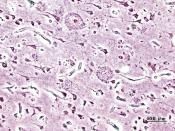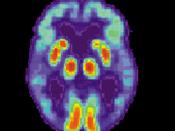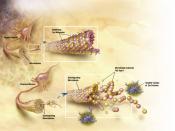Alzheimer's Disease is a progressive and irreversible brain disease that destroys mental and physical functioning in human beings, and invariably leads to death. It is the fourth leading cause of adult death in the United States. Alzheimer's creates emotional and financial catastrophe for many American families every year. Fortunately, a large amount of progress is being made to combat Alzheimer's disease every year.
To fully be able to comprehend and combat Alzheimer's disease, one must know what it does to the brain, the part of the human body it most greatly affects. Many Alzheimer's disease sufferers had their brains examined. A large number of differences were present when comparing the normal brain to the Alzheimer's brain. There was a loss of nerve cells from the Cerebral Cortex in the Alzheimer's victim. Approximately ten percent of the neurons in this region were lost. But a ten percent loss is relatively minor, and cannot account for the severe impairment suffered by Alzheimer's victims.
Neurofibrillary Tangles are also found in the brains of Alzheimer's victims. They are found within the cell bodies of nerve cells in the cerebral cortex, and take on the structure of a paired helix. Other diseases that have 'paired helixes' include Parkinson's disease, Down's Syndrome, and Dementia Pugilistica. Scientists are not sure how the paired helixes are related in these very different diseases.
Neuritic Plaques are patches of clumped material lying outside the bodies of nerve cells in the brain. They are mainly found in the cerebral cortex, but have also been seen in other areas of the brain. At the core of each of these plaques is a substance called amyloid, an abnormal protein not usually found in the brain. This amyloid core is surrounded by cast off fragments of dead or dying nerve cells. The cell fragments...



Diseases
In this paper it describes the desease's well. But it doesn't really explore futher into the each disease. A more in depth look into each disease would be helpful. Also the paper doesn't show the ways it affects a person in general. Also examples of people who have had these diseases.
5 out of 6 people found this comment useful.